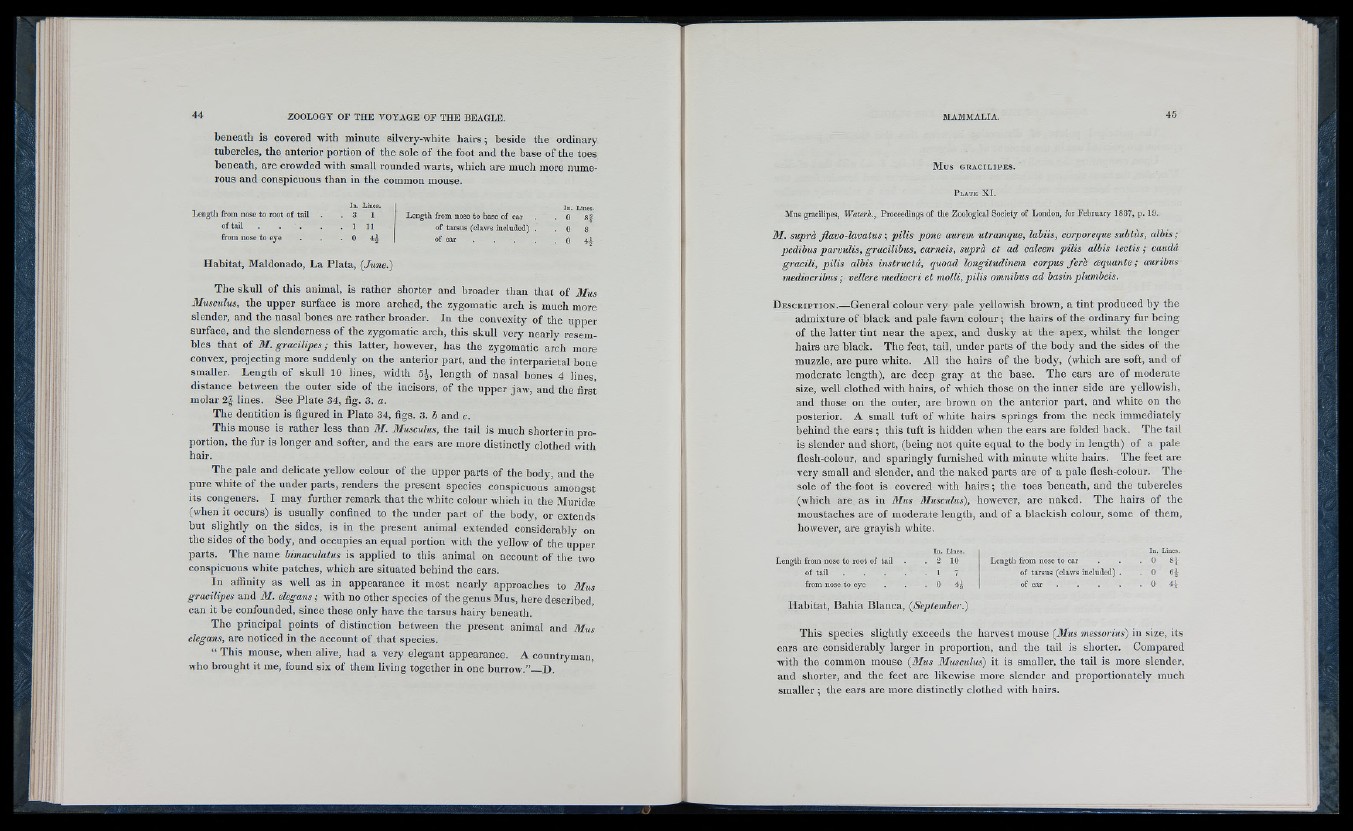
À
'a
ZO O LO G Y O F T IIE V O Y A G E O P T H E B EA G L E.
beneath is covered with minute silvery-white hairs; beside the ordinary
tubercles, the anterior portion of the sole of the foot and the base of the toes
beneath, are crowded with small rounded warts, which are much more numerous
and conspicuous than in the common mouse.
Length from nose to root of tail
of tail
from nose to eye
In. Lines.
3 1
1 11
0 44
from nose to base of ear
of tarsus (claws included) .
In, Lines.
0 8J
0 8
0 4i
Habitat, Maldonado, La Plata, (June.)
The skull of this animal, is ratlier shorter and broader than that of 3Ius
JIusculus, the upper surface is more arched, the zygomatic arch is much more
slender, and the nasal bones are rather broader. In the convexity of the upper
surface, and the slenderness of the zygomatic arch, this skull very nearly resembles
that of 31. gracilipes; this latter, however, has the zygomatic arch more
convex, projecting more suddenly on the anterior part, and the interparietal bone
smaller. Length of skull 10 lines, width 5J, length of nasal bones 4 lines,
distance between the outer side of the incisors, of the upper jaw, and the first
molar 2| lines. See Plate 34, fig. 3. a.
The dentition is figured in Plate 34, figs. 3. b and c.
This mouse is rather less than 31. 3Imculus, the tail is much shorter in proportion,
the fur is longer and softer, and the ears are more distinctly clothed with
hair.
The pale and delicate yellow colour of the upper parts of the body, and the
pure white of the under parts, renders the present species conspicuous amongst
its congeners. I may further remark that the white colour wliich in the Muridm
(when it occurs) is usually confined to the under part of the body, or extends
but slightly on the sides, is in the present animal extended considerably on
the sides of the body, and occupies an equal portion with the yellow of the upper
parts. The name bimaculatus is applied to this animal on account of the two
conspicuous white patches, which are situated behind the ears.
In affinity as well as in appearance it most nearly approaches to 3Ius
gracilipes and 31. elegans; with no other species of the genus Mus, here described,
can it be confounded, since these only have the tarsus hairy beneath.
The principal points of distinction between the present animal and 3Ius
elegans, are noticed in the account of that species.
“ Tills mouse, when alive, had a very elegant appearance. A countryman,
who brought it me, found six of them living together in one burrow.” D.
M u s O BACILIPES.
P late X I.
Mus gracilipes, Waterh., Proceedings of the Zoological Society of London, for February 1837, p. 19-
31. suprà Jîavo-lavatus ; pilis pone aurem utramque, labiis, corporeque subtùs, albis ;
pedibus parvulis, gracilibus, carneis, suprà et ad calcem pilis albis tectis ; caudâ
gracili, pilis albis instructâ, quoad longitudinem corpus ferè oequante ; auribus
mediocribus ; vellere mediocri et molli, pilis omnibus ad basin plumbeis.
D e s c r i p t i o n .— General colour very pale yellowish brown, a tint produced by the
admixture of black and pale fawn colour ; the hairs of the ordinary fur being
of the latter tint near the apex, and dusky at the apex, whilst the longer
hairs are black. The feet, tail, under parts of the body and the sides of the
muzzle, are pure white. All the hairs of the body, (which are soft, and of
moderate length), are deep gray at the base. The ears are of moderate
size, well clothed with hairs, of which those on the inner side are yellowish,
and those on the outer, are brown on the anterior part, and white on the
posterior. A small tuft of white hairs springs from the neck immediately
behind the ears ; this tuft is hidden when the ears are folded back. The tail
is slender and short, (being not quite equal to the body in length) of a pale
flesh-colour, and sparingly furnished with minute white hairs. The feet are
very small and slender, and the naked parts are of a pale flesh-colour. The
sole of the foot is covered with hairs ; the toes beneath, and the tubercles
(which are as in 3Ius 3Iusculus), however, are naked. The hairs of the
moustaches are of moderate length, and of a blackish colour, some of them,
however, are grayish white.
Length from nose to root of tail
of tail
from nose to eye
In. Lines.
2 10 Length from nose to ear
of tarsus (claws included) .
of ear . . . .
In. Lines.
0 84
0 64
0 4 4
Habitat, Bahia Blanca, (September.)
This species slightly exceeds the harvest mouse (3Ius messorius) in size, its
ears are considerably larger in proportion, and the tail is shorter. Compared
with the common mouse (3Ius 3Iuscidus) it is smaller, the tail is more slender,
and shorter, and the feet are likewise more slender and proportionately much
smaller ; the ears are more distinctly clothed with hairs.